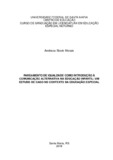| dc.contributor.advisor | Oliveira, Glaucimara Pires | |
| dc.creator | Morais, Andreza Stock | |
| dc.date.accessioned | 2019-01-14T10:59:46Z | |
| dc.date.available | 2019-01-14T10:59:46Z | |
| dc.date.issued | 2018-11-26 | |
| dc.date.submitted | 2018 | |
| dc.identifier.uri | http://repositorio.ufsm.br/handle/1/15329 | |
| dc.description | TCC de Graduação | por |
| dc.description.abstract | This work arises after insertion in a kindergarten unit, in a multi-age group where a
five-year-old child is in the process of being included, without a defined clinical diagnosis. Its characteristic is the delay in the development of neuromotor, presenting mainly
inefficiency in being able to be understood by the people around him, expressing verbally few words being these of little understanding, approximated of babbling. Realizing
their need to communicate with their peers and people around them, the question arises that gave rise to this research as: the acquisition of alternative communication by
a child who does not express verbal language and attends early childhood education,
the understanding and recognition of everyday school actions? The research had as
objective to analyze how the process of acquisition of alternative communication by a
child who does not express verbal language and attends to infantile education, enables
her to understand and recognize actions of school everyday. The methodology has as
proposal a case study having with instruments the field diary and filming of the service.
The research is divided in five chapters, being: Methodology, where I bring the adopted
procedures, type of research, brief description of the participant; Theoretical reference,
which was divided into three subheadings to facilitate the understanding of the researched subject, the subheadings bring the theoretical foundation referring to the researched topic, these were divided into: Historical Context of the Person with Disabilities
and Special Education in Brazil, Special Education Attendance, Assistive Technology
and Alternative Communication; Data Analysis and Discussion and final considerations. It was not possible to apply the alternative communication in full, however, the
work of recognition and identification of teachers was carried out. This recognition is
paramount for the proposal with the Alternative Communication to be effective with the
images that will be used for the actions requested. | eng |
| dc.language | por | por |
| dc.publisher | Universidade Federal de Santa Maria | por |
| dc.rights | Acesso Aberto | por |
| dc.rights.uri | http://creativecommons.org/licenses/by-nc-nd/4.0/ | * |
| dc.subject | Educação especial | por |
| dc.subject | Educação infantil | por |
| dc.subject | Comunicação alternativa | por |
| dc.subject | Pareamento de igualdade | por |
| dc.subject | Special education | eng |
| dc.subject | Early childhood education | eng |
| dc.subject | Alternative communication | eng |
| dc.subject | Equality matching | eng |
| dc.title | Pareamento de igualdade como introdução à comunicação alternativa na educação infantil: um estudo de caso no contexto da educação especial | por |
| dc.title.alternative | Equality matching as an introduction to alternative communication in early childhood education: a case study in the context of special education | eng |
| dc.type | Trabalho de Conclusão de Curso de Graduação | por |
| dc.degree.local | Santa Maria, RS, Brasil | por |
| dc.degree.graduation | Curso de Licenciatura em Educação Especial Noturno | por |
| dc.description.resumo | Este trabalho surge após inserção numa unidade de educação infantil, numa turma
multi-idade onde está em processo de inclusão uma criança de cinco anos, sem diagnóstico clínico definido. Tem como característica o atraso no desenvolvimento neuromotor, apresentando principalmente ineficiência em conseguir ser compreendida pelas pessoas à sua volta, expressando verbalmente poucas palavras sendo estas de
pouca compreensão, aproximadas de balbucios. Percebendo a sua necessidade de
se comunicar com os seus pares e pessoas ao seu redor, surge o questionamento que
deu origem a esta pesquisa como: a aquisição da comunicação alternativa por uma
criança que não expressa linguagem verbal e frequenta a educação infantil, possibilita
a ela a compreensão e reconhecimento de ações do cotidiano escolar? A pesquisa
teve como objetivo analisar como o processo de aquisição da comunicação alternativa
por uma criança que não expressa linguagem verbal e frequenta a educação infantil,
possibilita a ela a compreensão e reconhecimento de ações do cotidiano escolar. A
metodologia tem como proposta um estudo de caso tendo com instrumentos o diário
de campo e filmagens do atendimento. A pesquisa está dividida em cinco capítulos,
sendo eles: Metodologia, onde trago os procedimentos adotados, tipo de pesquisa,
breve descrição da participante; Referencial teórico o qual foi dividido em três subtítulos para facilitar a compreensão da temática pesquisada, os subtítulos trazem a fundamentação teórica referente ao tema pesquisado, estes foram divididos em: Contexto
Histórico da Pessoa com Deficiência e a Educação Especial no Brasil, A educação
Infantil e o Atendimento da Educação Especial, Tecnologia Assistiva e Comunicação
Alternativa; Análise e Discussão dos Dados e considerações finais. Não foi possível realizar a aplicação da comunicação alternativa na íntegra, porém, foi realizado
o trabalho de reconhecimento e identificação de professores. Esse reconhecimento
é primordial para que a proposta com a Comunicação Alternativa se efetive com as
imagens que serão utilizadas para as ações solicitadas. | por |
| dc.publisher.country | Brasil | por |
| dc.publisher.initials | UFSM | por |
| dc.subject.cnpq | CNPQ::CIENCIAS HUMANAS::EDUCACAO::TOPICOS ESPECIFICOS DE EDUCACAO::EDUCACAO ESPECIAL | por |
| dc.publisher.unidade | Centro de Educação | por |



